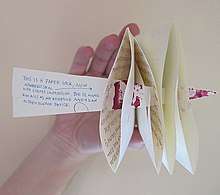Letterlocking
Letterlocking is the securing of a letter without an envelope using folding and cutting.[1] The process of letterlocking dates to the 13th century in Western history, corresponding with the availability of flexible writing paper.[2] Letterlocking uses small slits, tab, and holes placed directly in to a letter, which combined with folding techniques are used to secure the letter, preventing reading the letter without breaking seals or slips, providing a means of tamper resistance.[3] These folds and holes may be additionally secured with string and sealing wax.[4] Intricate letterlocking works contain artistic elements, demonstrating more than a utilitarian purpose.[5] While the use of sealing techniques may have been limited to ecclesiastic and the nobility, letterlocking was historically performed by all classes of writers.[6] An individual could also be recognised by their personal technique of folding, as was the case with Jane Whorwood, of whose letter Charles I, imprisoned in Carisbrooke Castle on the Isle of WIght, wrote “This Note [...] I know, by the fowldings [...] that it is written by [Mrs Whorwood]“.[7]

The term letterlocking was coined in 2009 by Jana Dambrogio, Thomas F. Peterson (1957) Conservator of MIT Libraries, who has been the primary force in researching the practice for many years.[8]
References
- "Letterlocking". Letterlocking. Retrieved 2019-07-13.
- Cain, Abigail (2018-11-09). "Before Envelopes, People Protected Messages With Letterlocking". Atlas Obscura. Retrieved 20 March 2019.
- Denny, Heather. "The art and science of letterlocking". MIT News. Retrieved 20 March 2019.
- Kahn, Eve (2015-09-17). "A Trove of 'Letterlocking,' or Vintage Strategies to Deter Snoops". The New York Times. Retrieved 20 March 2019.
- Smith, Helen (2017). "'A unique instance of art': The Proliferating Surfaces of Early Modern Paper". Journal of the Northern Renaissance (8): 2–37. ISSN 1759-3085. Accession 124313720.
- Ahrendt, Rebekah; Van der Linden, David (2017). "The Postmasters' Piggy Bank: Experiencing the Accidental Archive". French Historical Studies. 40 (2): 189–213. doi:10.1215/00161071-3761583. ISSN 0016-1071.
- Akkerman, Nadine (2018). Invisible agents women and espionage in seventeenth-century Britain. Oxford University Press. p. 21. ISBN 9780198823018. OCLC 1048595615.
- "Letterlock™". Jana Dambrogio. Retrieved 2019-07-13.